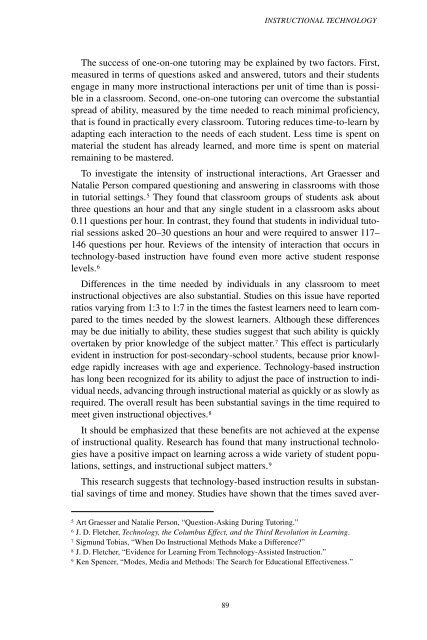Analytic Culture in the U.S. Intelligence Community (PDF) - CIA
Analytic Culture in the U.S. Intelligence Community (PDF) - CIA
Analytic Culture in the U.S. Intelligence Community (PDF) - CIA
You also want an ePaper? Increase the reach of your titles
YUMPU automatically turns print PDFs into web optimized ePapers that Google loves.
INSTRUCTIONAL TECHNOLOGY<br />
The success of one-on-one tutor<strong>in</strong>g may be expla<strong>in</strong>ed by two factors. First,<br />
measured <strong>in</strong> terms of questions asked and answered, tutors and <strong>the</strong>ir students<br />
engage <strong>in</strong> many more <strong>in</strong>structional <strong>in</strong>teractions per unit of time than is possible<br />
<strong>in</strong> a classroom. Second, one-on-one tutor<strong>in</strong>g can overcome <strong>the</strong> substantial<br />
spread of ability, measured by <strong>the</strong> time needed to reach m<strong>in</strong>imal proficiency,<br />
that is found <strong>in</strong> practically every classroom. Tutor<strong>in</strong>g reduces time-to-learn by<br />
adapt<strong>in</strong>g each <strong>in</strong>teraction to <strong>the</strong> needs of each student. Less time is spent on<br />
material <strong>the</strong> student has already learned, and more time is spent on material<br />
rema<strong>in</strong><strong>in</strong>g to be mastered.<br />
To <strong>in</strong>vestigate <strong>the</strong> <strong>in</strong>tensity of <strong>in</strong>structional <strong>in</strong>teractions, Art Graesser and<br />
Natalie Person compared question<strong>in</strong>g and answer<strong>in</strong>g <strong>in</strong> classrooms with those<br />
<strong>in</strong> tutorial sett<strong>in</strong>gs. 5 They found that classroom groups of students ask about<br />
three questions an hour and that any s<strong>in</strong>gle student <strong>in</strong> a classroom asks about<br />
0.11 questions per hour. In contrast, <strong>the</strong>y found that students <strong>in</strong> <strong>in</strong>dividual tutorial<br />
sessions asked 20–30 questions an hour and were required to answer 117–<br />
146 questions per hour. Reviews of <strong>the</strong> <strong>in</strong>tensity of <strong>in</strong>teraction that occurs <strong>in</strong><br />
technology-based <strong>in</strong>struction have found even more active student response<br />
levels. 6<br />
Differences <strong>in</strong> <strong>the</strong> time needed by <strong>in</strong>dividuals <strong>in</strong> any classroom to meet<br />
<strong>in</strong>structional objectives are also substantial. Studies on this issue have reported<br />
ratios vary<strong>in</strong>g from 1:3 to 1:7 <strong>in</strong> <strong>the</strong> times <strong>the</strong> fastest learners need to learn compared<br />
to <strong>the</strong> times needed by <strong>the</strong> slowest learners. Although <strong>the</strong>se differences<br />
may be due <strong>in</strong>itially to ability, <strong>the</strong>se studies suggest that such ability is quickly<br />
overtaken by prior knowledge of <strong>the</strong> subject matter. 7 This effect is particularly<br />
evident <strong>in</strong> <strong>in</strong>struction for post-secondary-school students, because prior knowledge<br />
rapidly <strong>in</strong>creases with age and experience. Technology-based <strong>in</strong>struction<br />
has long been recognized for its ability to adjust <strong>the</strong> pace of <strong>in</strong>struction to <strong>in</strong>dividual<br />
needs, advanc<strong>in</strong>g through <strong>in</strong>structional material as quickly or as slowly as<br />
required. The overall result has been substantial sav<strong>in</strong>gs <strong>in</strong> <strong>the</strong> time required to<br />
meet given <strong>in</strong>structional objectives. 8<br />
It should be emphasized that <strong>the</strong>se benefits are not achieved at <strong>the</strong> expense<br />
of <strong>in</strong>structional quality. Research has found that many <strong>in</strong>structional technologies<br />
have a positive impact on learn<strong>in</strong>g across a wide variety of student populations,<br />
sett<strong>in</strong>gs, and <strong>in</strong>structional subject matters. 9<br />
This research suggests that technology-based <strong>in</strong>struction results <strong>in</strong> substantial<br />
sav<strong>in</strong>gs of time and money. Studies have shown that <strong>the</strong> times saved aver-<br />
5<br />
Art Graesser and Natalie Person, “Question-Ask<strong>in</strong>g Dur<strong>in</strong>g Tutor<strong>in</strong>g.”<br />
6<br />
J. D. Fletcher, Technology, <strong>the</strong> Columbus Effect, and <strong>the</strong> Third Revolution <strong>in</strong> Learn<strong>in</strong>g.<br />
7<br />
Sigmund Tobias, “When Do Instructional Methods Make a Difference?”<br />
8<br />
J. D. Fletcher, “Evidence for Learn<strong>in</strong>g From Technology-Assisted Instruction.”<br />
9<br />
Ken Spencer, “Modes, Media and Methods: The Search for Educational Effectiveness.”<br />
89
















